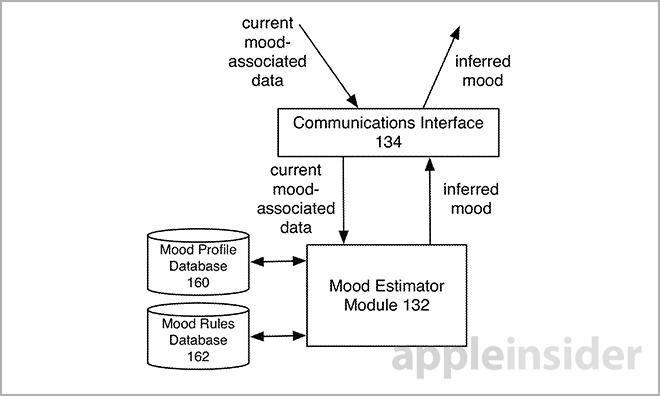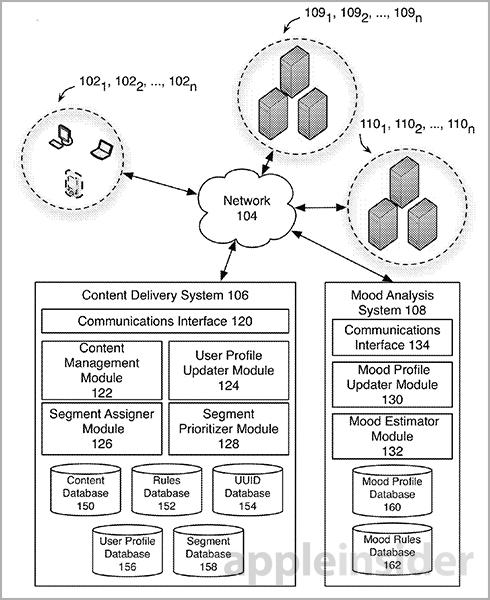The U.S. Patent and Trademark Office on Thursday published a peculiar Apple filing describing an ad service that targets users based on hard-to-quantify metrics like behavior and mood.
Apple's "Inferring user mood based on user and group characteristic data" patent application looks to offer advertisers and content providers a more intuitive and effective way to target users.
As noted in the document, a user's responsiveness to targeted content delivery — advertisements — can be affected by any number of factors. Among these are location, time of day, current activity and mood. Apple wants to leverage user mood and mood-associated characteristic data to provide a more accurate method of ad targeting.
In addition to mood, the system takes into account user demographics, behavior, location, time, how the ad is served, the package contents and more.
According to the filing, the system analyzes mood data collected over a set period of time to generate a "baseline mood profile" for a user. By comparing a user's mood-associated data against various "mood rules," the method can infer how a user is feeling at a given moment and subsequently serve up an appropriate ad.
Described by the filing, mood-associated characteristics can be physical, behavioral or spatial-temporal. For example, heart rate, blood pressure, adrenaline level, perspiration, body temperature and vocal expressions may all be used to determine a user's mood. Behavioral cues include type of media is being consumed, the sequence in which apps are launched and social networking activities, among others. Time and location data can be used to infer mood by comparing it with stored mood-associated characteristics.
In some embodiments, mood is gauged by a camera which, when used in tandem with facial recognition software, can measure facial expressions.
On the backend, a database consisting of a user's profile is automatically updated based on a set of rules instituted either by the user or the system. Pieces of the profile may be revised as needed based on learning algorithms that tap into external data like iTunes registration and usage information.
Once user mood characteristic data is gathered a mood can be inferred based on a set of predefined rules. These rules act off a user's baseline mood, which is applied on a per-user basis. For example, one user's baseline may be happy, while another user is sad.
Based on the current inferred mood, the system determines how likely a user is to interact with a given ad and serves up mood-appropriate content. At this point, a segment assigner module applies a set of user characteristics to a given ad before pushing it out. For example, the document notes content will be sent out if a user meets the following criteria: "gender, male; age, 19-24; location, Northern California or New York City; mood, happy."
The patent filing goes on to explain the system in exhaustive detail, including rules to be applied to user data to estimate and infer moods, baseline mood analysis and tagging, data collection systems and more.
Apple dedicates a part of the property to address privacy concerns and states the information gathered should not be used for nefarious purposes. The system is meant to enhance user experience by serving relevant ads while at the same time providing advertisers with more effective distribution tools.
With the U.S. grappling with privacy issues brought to the fore by recent revelations regarding the NSA's surveillance policies, it is unlikely that Apple's invention will be applied anytime soon.
Apple's mood-based ad system patent application was first filed for in 2012 and credits Michael Froimowitz Greenzeiger, Ravindra Phulari and Mehul K. Sanghavi as its inventors.
 Mikey Campbell
Mikey Campbell








-m.jpg)






 Christine McKee
Christine McKee
 Amber Neely
Amber Neely
 Andrew Orr
Andrew Orr

 Sponsored Content
Sponsored Content

 William Gallagher
William Gallagher









20 Comments
:err:
When I started reading this article, I was curious about how a mood could be recognized. At paragraph six, sentence two I had the lightbulb moment. All of the biometric work Apple is being about might very well be on target. The Topsy purchase will pull all of the collected data together for analysis in my opinion. I was excited then nervous about so much data residing on Apple's servers. I felt this was an intrusion at a scale unprecedented before. I do not think Google has anything like this currently. I cautiously read the rest of the article and realized how truly secretive Apple is! So many competitors are either not doing enough individual research to make outstanding biometric products before shipping or are just waiting to discover what Apple does. Apple is doing truly innovative research!! Back to being nervous... How will/can the data be protected from the NSA and other US government departments? Having data centers outside the USA is a great start but European and Asian governments could step in to replace the nefarious activities of the USA. This is an awesome patent but extreme caution is needed if a move forward is decided by Apple. Hello, Gatorguy. ????
I've got a great idea for Google to counter Apple's mood determination algorithms. Just include a "I'm not in the mood to see intrusive advertisements." checkbox. This, of course, will put Google out of business, but they're a clever bunch, so maybe they could make some money by tricking Facebook into licensing the technology.
Indeed!
It is all very intrusively freaky, the future of advertising.
But it could have some medical usefulness.
No thanks, I don't want my phone listening to me and watching me to determine my mood so it can serve me ads. This sounds like something Google would do. I can imagine if this article was about Google, people here would be having a field day with it.